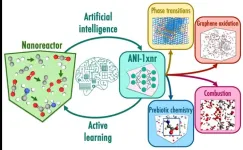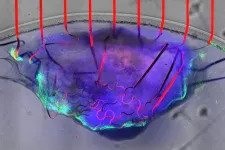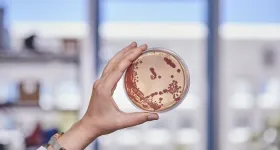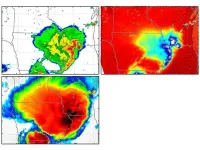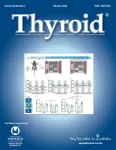(Press-News.org) The ability to simulate the behavior of systems at the atomic level represents a powerful tool for everything from drug design to materials discovery. A team led by Los Alamos National Laboratory researchers has developed machine learning interatomic potentials that predict molecular energies and forces acting on atoms, enabling simulations that save time and expense compared with existing computational methods.
“Machine learning potentials increasingly offer an effective alternative to computationally expensive simulations that try to represent complex physical systems on the atomic scale,” said Benjamin Nebgen, Los Alamos chemical physicist and co-author of a recent Nature Chemistry paper describing the work. “A general reactive machine learning interatomic potential, applicable to a broad range of reactive chemistry without the need for refitting, will greatly benefit chemistry and materials science.”
Bridging the gap in effective simulations
Building effective simulations for molecular dynamics in chemistry is traditionally done with physics-based computational models, including classical force fields or quantum mechanics. While quantum mechanical models are accurate and generally applicable, they are extremely computationally expensive. By contrast, classical force fields are computationally efficient, but of relatively low accuracy and only applicable to a limited range of systems. ANI-1xnr, the team’s transformational machine learning model, bridges the gap in speed, accuracy and generality that has existed in chemistry for many decades. (Machine learning is an application of artificial intelligence where computer programs “learn” through training.)
ANI-1xnr represents the first reactive machine learning interatomic potential general enough — it can be applied to many different chemical systems — to compete with physics-based computational models for performing large-scale reactive atomistic simulations. ANI-1xnr was developed using an automated workflow that performed reactive molecular dynamics simulations over a wide range of chemical systems containing carbon, hydrogen, nitrogen and oxygen elements.
ANI-1xnr proved capable of studying a diverse range of systems, from carbon phase transitions to combustion to prebiotic chemistry. The team validated the simulations by comparing them with results from experiments and from conventional computational techniques.
A transformational interatomic potential
“ANI-1xnr does not require domain expertise or refitting for every new use case, enabling scientists from a diverse range of domains to study unknown chemistry,” said Richard Messerly, computational scientist at Los Alamos and co-corresponding author of the paper. “The general applicability of ANI-1xnr is transformational, representing a significant step toward replacing the long-standing modeling techniques for studying reactive chemistry at scale.”
The data set used by the team and the ANI-1xnr code has been made publicly available to the research community.
Paper: “Exploring the frontiers of condensed-phase chemistry with a general reactive machine learning potential.” Nature Chemistry. DOI: 10.1038/s41557-023-01427-3
Funding: The work was supported by the DOE Office of Science, Basic Energy Sciences’ Chemical Sciences, Geosciences, and Biosciences Division and by the Laboratory Directed Research and Development program at Los Alamos. Work at Los Alamos was performed in part at the Center for Nonlinear Studies and at the Center for Integrated Nanotechnologies, a DOE Office of Science user facility. This research used resources provided by Los Alamos’ Institutional Computing Program.
END
Artificial intelligence helps explore chemistry frontiers
Machine learning helps simulate reactive molecular dynamics for research and discovery
2024-03-21
ELSE PRESS RELEASES FROM THIS DATE:
UMass Amherst engineers create bioelectronic mesh capable of growing with cardiac tissues for comprehensive heart monitoring
2024-03-21
AMHERST, Mass. – A team of engineers led by the University of Massachusetts Amherst and including colleagues from the Massachusetts Institute of Technology (MIT) recently announced in the journal Nature Communications that they had successfully built a tissue-like bioelectronic mesh system integrated with an array of atom-thin graphene sensors that can simultaneously measure both the electrical signal and the physical movement of cells in lab-grown human cardiac tissue. In a research first, this tissue-like mesh can grow along with the cardiac cells, ...
Researchers take major step toward developing next-generation solar cells
2024-03-21
The solar energy world is ready for a revolution. Scientists are racing to develop a new type of solar cell using materials that can convert electricity more efficiently than today’s panels.
In a new paper published February 26 in the journal Nature Energy, a University of Colorado Boulder researcher and his international collaborators unveiled an innovative method to manufacture the new solar cells, known as perovskite cells, an achievement critical for the commercialization of what ...
CUNY ISPH to launch next phase of community-based cohort study to track short- and long-term effects of multiple respiratory viruses
2024-03-21
The City University of New York (CUNY) Institute for Implementation Science in Population Health (ISPH) and the CUNY Graduate School of Public Health and Health Policy (CUNY SPH), in collaboration with Pfizer, are initiating a critical two-year prospective epidemiologic study in the spring of 2024 to track acute respiratory infections across the United States.
Project PROTECTS (Prospective Respiratory Outcomes from Tracking and Evaluating Community-based TeSting) builds on the CHASING COVID Cohort Study, which has monitored SARS-CoV-2 infection rates and ...
47th Annual UNC Lineberger Scientific Symposium: “Pancreatic Cancer: From Discovery to the Clinic”
2024-03-21
UNC Lineberger Comprehensive Cancer Center is hosting its 47th annual scientific symposium, “Pancreatic Cancer: From Discovery to the Clinic,” on May 21-22 at the Friday Center for Continuing Education in Chapel Hill, North Carolina.
The symposium is free and will feature 15 talks on the latest in pancreatic cancer basic, translational and clinical research by faculty at the University of North Carolina, Dana-Farber Cancer Institute, Johns Hopkins Sidney Kimmel Cancer Center, Memorial Sloan Kettering Cancer Center, University of Michigan ...
A new path to drug diversity
2024-03-21
Many important medicines, such as antibiotics and anticancer drugs, are derived from natural products from Bacteria. The enzyme complexes that produce these active ingredients have a modular design that makes them ideal tools for synthetic biology. By exploring protein evolution, a team led by Helge Bode from the Max Planck Institute for Terrestrial Microbiology in Marburg, Germany, has found new "fusion sites" that enable faster and more targeted drug development.
Industry often follows the assembly line principle: components are systematically assembled into complex products, with different production lines yielding different products. However, not humans are the ...
Satellite data assimilation improves forecasts of severe weather
2024-03-21
UNIVERSITY PARK, Pa. — In 2020, a line of severe thunderstorms unleashed powerful winds that caused billions in damages across the Midwest United States. A technique developed by Penn State scientists that incorporates satellite data could improve forecasts — including where the most powerful winds will occur — for similar severe weather events.
The researchers reported in the journal Geophysical Research Letters that adding microwave data collected by low-Earth-orbiting satellites to existing computer weather forecast models produced more accurate forecasts of surface gusts in a case study of the 2020 Midwest ...
Morality among low-risk differentiated thyroid cancer survivors in the U.S.
2024-03-21
A new study has shown that overall and cause-specific mortality rates in individuals in the U.S. with low-risk differentiated thyroid cancer (DTC) are low. The study is published in the peer-reviewed journal Thyroid®, the official journal of the American Thyroid Association® (ATA®). Click here to read the article now.
Cari Kitahara, PhD, from the National Cancer Institute, National Institutes of Health, and coauthors identified 51,854 individuals diagnosed with first primary DTC at low risk ...
Most detailed atlas to date of human blood stem cells could guide future leukemia care
2024-03-21
Thanks to an unusual application of game theory and machine learning technology, a large team of scientists led by experts at Cincinnati Children’s has published the world’s most detailed “atlas” of the many types of stem cells and early progenitors involved in producing human blood from diverse donors.
The team has identified more than 80 distinct subsets of hematopoietic stem and progenitor cells (HSPCs) – early-stage cells that kick off production of mature red cells, white cells ...
Novel method to measure root depth may lead to more resilient crops
2024-03-21
UNIVERSITY PARK, Pa. — As climate change worsens global drought conditions, hindering crop production, the search for ways to capture and store atmospheric carbon causing the phenomenon has intensified. Penn State researchers have developed a new high-tech tool that could spur changes in how crops withstand drought, acquire nitrogen and store carbon deeper in soil.
In findings published in the January issue of Crop Science, they describe a process in which the depth of plant roots can be accurately estimated by scanning leaves with ...
Scientists develop catalyst designed to make ammonia production more sustainable
2024-03-21
Ammonia is one of the most widely produced chemicals in the world, and is used in a great many manufacturing and service industries. The conventional production technology is the Haber-Bosch process, which combines nitrogen gas (N2) and hydrogen gas (H2) in a reactor in the presence of a catalyst. This process requires high levels of temperature and pressure, resulting in substantial power consumption. Indeed, ammonia production is estimated to consume 1%-2% of the world’s electricity and to account for about 3% of global carbon emissions.
In pursuit of more sustainable alternatives, researchers affiliated with the Center for Development of Functional Materials (CDMF) ...
LAST 30 PRESS RELEASES:
Injectable breast ‘implant’ offers alternative to traditional surgeries
Neuroscientists devise formulas to measure multilingualism
New prostate cancer trial seeks to reduce toxicity without sacrificing efficacy
Geometry shapes life
A CRISPR screen reveals many previously unrecognized genes required for brain development and a new neurodevelopmental disorder
Hot flush treatment has anti-breast cancer activity, study finds
Securing AI systems against growing cybersecurity threats
Longest observation of an active solar region
Why nail-biting, procrastination and other self-sabotaging behaviors are rooted in survival instincts
Regional variations in mechanical properties of porcine leptomeninges
Artificial empathy in therapy and healthcare: advancements in interpersonal interaction technologies
Why some brains switch gears more efficiently than others
UVA’s Jundong Li wins ICDM’S 2025 Tao Li Award for data mining, machine learning
UVA’s low-power, high-performance computer power player Mircea Stan earns National Academy of Inventors fellowship
Not playing by the rules: USU researcher explores filamentous algae dynamics in rivers
Do our body clocks influence our risk of dementia?
Anthropologists offer new evidence of bipedalism in long-debated fossil discovery
Safer receipt paper from wood
Dosage-sensitive genes suggest no whole-genome duplications in ancestral angiosperm
First ancient human herpesvirus genomes document their deep history with humans
Why Some Bacteria Survive Antibiotics and How to Stop Them - New study reveals that bacteria can survive antibiotic treatment through two fundamentally different “shutdown modes”
UCLA study links scar healing to dangerous placenta condition
CHANGE-seq-BE finds off-target changes in the genome from base editors
The Journal of Nuclear Medicine Ahead-of-Print Tip Sheet: January 2, 2026
Delayed or absent first dose of measles, mumps, and rubella vaccination
Trends in US preterm birth rates by household income and race and ethnicity
Study identifies potential biomarker linked to progression and brain inflammation in multiple sclerosis
Many mothers in Norway do not show up for postnatal check-ups
Researchers want to find out why quick clay is so unstable
Superradiant spins show teamwork at the quantum scale
[Press-News.org] Artificial intelligence helps explore chemistry frontiersMachine learning helps simulate reactive molecular dynamics for research and discovery
